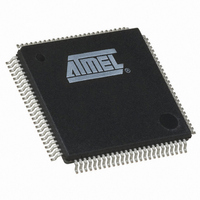AT91SAM7A3-AU Atmel, AT91SAM7A3-AU Datasheet - Page 135

AT91SAM7A3-AU
Manufacturer Part Number
AT91SAM7A3-AU
Description
IC ARM7 MCU FLASH 256K 100LQFP
Manufacturer
Atmel
Series
AT91SAMr
Specifications of AT91SAM7A3-AU
Core Processor
ARM7
Core Size
16/32-Bit
Speed
60MHz
Connectivity
CAN, I²C, MMC, SPI, SSC, UART/USART
Peripherals
POR, PWM, WDT
Number Of I /o
62
Program Memory Size
256KB (256K x 8)
Program Memory Type
FLASH
Ram Size
32K x 8
Voltage - Supply (vcc/vdd)
1.65 V ~ 1.95 V
Data Converters
A/D 8x10b
Oscillator Type
Internal
Operating Temperature
-40°C ~ 85°C
Package / Case
100-LQFP
Controller Family/series
AT91SAM7xx
No. Of I/o's
62
Ram Memory Size
32KB
Cpu Speed
60MHz
No. Of Timers
3
Rohs Compliant
Yes
Package
100LQFP
Device Core
ARM7TDMI
Family Name
91S
Maximum Speed
60 MHz
Operating Supply Voltage
3.3 V
Data Bus Width
32 Bit
Number Of Programmable I/os
62
Interface Type
CAN/SPI/I2S/TWI/USART/USB
On-chip Adc
2(8-chx10-bit)
Number Of Timers
3
Processor Series
AT91SAMx
Core
ARM7TDMI
Data Ram Size
32 KB
Maximum Clock Frequency
60 MHz
Maximum Operating Temperature
+ 85 C
Mounting Style
SMD/SMT
3rd Party Development Tools
JTRACE-ARM-2M, MDK-ARM, RL-ARM, ULINK2
Development Tools By Supplier
AT91SAM-ICE, AT91-ISP, AT91SAM7A3-EK
Minimum Operating Temperature
- 40 C
Cpu Family
91S
Device Core Size
32b
Frequency (max)
60MHz
Total Internal Ram Size
32KB
# I/os (max)
62
Number Of Timers - General Purpose
3
Operating Supply Voltage (typ)
3.3V
Operating Supply Voltage (max)
3.6V
Operating Supply Voltage (min)
3V
Instruction Set Architecture
RISC
Operating Temp Range
-40C to 85C
Operating Temperature Classification
Industrial
Mounting
Surface Mount
Pin Count
100
Package Type
LQFP
For Use With
AT91SAM-ICE - EMULATOR FOR AT91 ARM7/ARM9AT91SAM7A3-EK - KIT EVAL FOR AT91SAM7A3
Lead Free Status / RoHS Status
Lead free / RoHS Compliant
Eeprom Size
-
Lead Free Status / Rohs Status
Details
Available stocks
Company
Part Number
Manufacturer
Quantity
Price
Company:
Part Number:
AT91SAM7A3-AU
Manufacturer:
MXIC
Quantity:
1 001
Company:
Part Number:
AT91SAM7A3-AU
Manufacturer:
Atmel
Quantity:
730
- Current page: 135 of 594
- Download datasheet (7Mb)
22.7.4
22.7.4.1
22.7.4.2
22.7.4.3
22.7.4.4
6042E–ATARM–14-Dec-06
Fast Interrupt
Fast Interrupt Source
Fast Interrupt Control
Fast Interrupt Vectoring
Fast Interrupt Handlers
The interrupt source 0 is the only source which can raise a fast interrupt request to the proces-
sor except if fast forcing is used. The interrupt source 0 is generally connected to a FIQ pin of
the product, either directly or through a PIO Controller.
The fast interrupt logic of the AIC has no priority controller. The mode of interrupt source 0 is
programmed with the AIC_SMR0 and the field PRIOR of this register is not used even if it
reads what has been written. The field SRCTYPE of AIC_SMR0 enables programming the
fast interrupt source to be positive-edge triggered or negative-edge triggered or high-level sen-
sitive or low-level sensitive
Writing 0x1 in the AIC_IECR (Interrupt Enable Command Register) and AIC_IDCR (Interrupt
Disable Command Register) respectively enables and disables the fast interrupt. The bit 0 of
AIC_IMR (Interrupt Mask Register) indicates whether the fast interrupt is enabled or disabled.
The fast interrupt handler address can be stored in AIC_SVR0 (Source Vector Register 0).
The value written into this register is returned when the processor reads AIC_FVR (Fast Vec-
tor Register). This offers a way to branch in one single instruction to the interrupt handler, as
AIC_FVR is mapped at the absolute address 0xFFFF F104 and thus accessible from the ARM
fast interrupt vector at address 0x0000 001C through the following instruction:
When the processor executes this instruction it loads the value read in AIC_FVR in its pro-
gram counter, thus branching the execution on the fast interrupt handler. It also automatically
performs the clear of the fast interrupt source if it is programmed in edge-triggered mode.
This section gives an overview of the fast interrupt handling sequence when using the AIC. It
is assumed that the programmer understands the architecture of the ARM processor, and
especially the processor interrupt modes and associated status bits.
Assuming that:
When nFIQ is asserted, if the bit “F” of CPSR is 0, the sequence is:
1. The Advanced Interrupt Controller has been programmed, AIC_SVR0 is loaded with
2. The Instruction at address 0x1C (FIQ exception vector address) is required to vector
3. The user does not need nested fast interrupts.
1. The CPSR is stored in SPSR_fiq, the current value of the program counter is loaded
2. The ARM core enters FIQ mode.
3. When the instruction loaded at address 0x1C is executed, the program counter is
LDR
LDR PC, [PC, # -&F20]
the fast interrupt service routine address, and the interrupt source 0 is enabled.
the fast interrupt:
in the FIQ link register (R14_FIQ) and the program counter (R15) is loaded with
0x1C. In the following cycle, during fetch at address 0x20, the ARM core adjusts
R14_fiq, decrementing it by four.
loaded with the value read in AIC_FVR. Reading the AIC_FVR has effect of automat-
PC,[PC,# -&F20]
AT91SAM7A3 Preliminary
135
Related parts for AT91SAM7A3-AU
Image
Part Number
Description
Manufacturer
Datasheet
Request
R

Part Number:
Description:
MCU ARM9 64K SRAM 144-LFBGA
Manufacturer:
Atmel
Datasheet:

Part Number:
Description:
IC ARM9 MPU 217-LFBGA
Manufacturer:
Atmel
Datasheet:

Part Number:
Description:
MCU ARM9 ULTRA LOW PWR 217-LFBGA
Manufacturer:
Atmel
Datasheet:

Part Number:
Description:
MCU ARM9 324-TFBGA
Manufacturer:
Atmel
Datasheet:

Part Number:
Description:
IC MCU ARM9 SAMPLING 217CBGA
Manufacturer:
Atmel
Datasheet:

Part Number:
Description:
IC ARM9 MCU 217-LFBGA
Manufacturer:
Atmel
Datasheet:

Part Number:
Description:
IC ARM9 MCU 208-PQFP
Manufacturer:
Atmel
Datasheet:

Part Number:
Description:
MCU ARM 512K HS FLASH 100-LQFP
Manufacturer:
Atmel
Datasheet:

Part Number:
Description:
MCU ARM 512K HS FLASH 100-TFBGA
Manufacturer:
Atmel
Datasheet:

Part Number:
Description:
IC ARM9 MCU 200 MHZ 324-TFBGA
Manufacturer:
Atmel
Datasheet:

Part Number:
Description:
IC ARM MCU 16BIT 128K 256BGA
Manufacturer:
Atmel
Datasheet:

Part Number:
Description:
IC ARM7 MCU 32BIT 128K 64LQFP
Manufacturer:
Atmel
Datasheet:

Part Number:
Description:
IC ARM7 MCU FLASH 256K 128-LQFP
Manufacturer:
Atmel
Datasheet:

Part Number:
Description:
IC ARM7 MCU FLASH 512K 128-LQFP
Manufacturer:
Atmel
Datasheet:

Part Number:
Description:
IC ARM9 MPU 217-LFBGA
Manufacturer:
Atmel
Datasheet:











